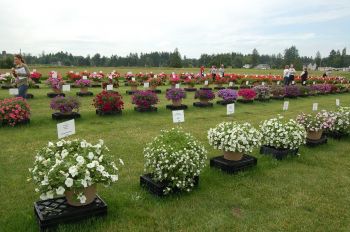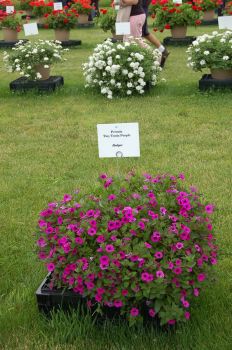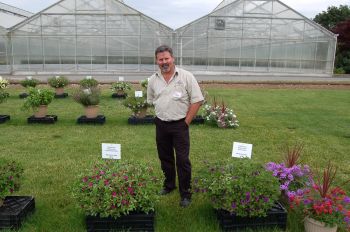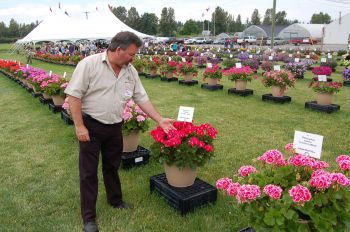
After being in the doldrums for a while,
geraniums have been coming “back in the game” the past three years,
says Ball Seed regional sales director Yves Cournoyer.
Consumers like its ease-of-use and reliability during the season
 |
| Photos by David Schmidt A tiny-petalled Bodger petunia: (top) an overview of the expansive Westcan trials. |
 |
After being in the doldrums for a while, geraniums have been coming “back in the game” the past three years, says Ball Seed regional sales director Yves Cournoyer.
Cournoyer was one of several seed company representatives attending the 11th annual spring trials open house at Westcan Greenhouses in Langley, British Columbia.
One of six open trials held across the continent, the Westcan trials gave several hundred seed companies, growers and retailers a chance to compare almost 300 different varieties of geraniums from Ball, Dummen, Fischer, Oglevee/JVK, Selecta First Class, and S& G Flowers. Also included were almost 400 other spring flowers, including angelonias, argyranthemums, bacopas, begonias, bracteanthas, calibrachoas, diascias, fuchsias, impatiens, lobelias, nemesias, osteospermums, penstemons, petunias and verbenas.
“This is one of the best trials,” Cournoyer notes, explaining that it is a true comparative trial where all plants are grown the same way.
While the Westcan trials began as a geranium trial, the proliferation of plants now being included indicates the wide variety of flower species being grown in greenhouses and nurseries today. At the same time, the fact geraniums remain the largest species in the trial is a testament to its staying power.
Cournoyer credits the resurgence of the geranium to the fact it is easy for consumers to maintain. He calls it a “secure” plant unlike many of the other plants that require more care to grow. “People are never disappointed. Consumers can buy a geranium and forget about it.”
Plants like the calibrachoa, verbena, bacopa and bracteantha are declining in popularity because consumers find them more difficult to grow. Geraniums are also replacing bedding plants due to changing consumer preferences. “Before it was do-it-yourself, now it’s ‘do it for me.’ Potted plants are taking over the marketplace,” Cournoyer says.
 |
| Photo by David Schmidt Gary Moran of Northern Innovators, with two new Mini-Famous calibrachoa developed by Selecta First Class. |
Rather than landscape their yard, consumers are now buying containers to “decorate” their yard. They see the pots, which generally come from Mexico and China, as “sculptures” and expect garden centres to fill them. That puts a new kind of pressure on growers and retailers. They not only have to be able to grow the plants, they also have to be able to create attractive plant combinations.
“Some people are disappointed with the basket stuffers they receive. Too many growers are inexperienced and put the wrong plants together,” Cournoyer explains. “You have to be careful with the mix.”
For example, containers intended for full sun must only include plants suited to full sun, while those intended for shady areas must have plants suited to shade. Plants must also be selected to complement each other in a mix. For example, a small plant with small flowers should not be put in the same basket as a large plant with lots of foliage as it will only get lost. Growers also need to have an eye for colour, as the colours in a container must complement each other.
 |
| Photo by David Schmidt Gary Moran of Northern Innovators admires ‘Moonlight Strawberry Blush’ pelargornium from Selecta First Class. |
Colour is another reason more consumers are turning to container plants. Unlike a perennial landscape, in which the colours are set for years, containers allow homeowners to decorate to a specific theme and to change that theme on a moment’s notice.
While the changing demand is recreating opportunities for geranium growers, it is making life more difficult for bedding plant growers.
“It’s forcing companies doing seed for bedding plants to come up with better products,” says Cournoyer.
Print this page